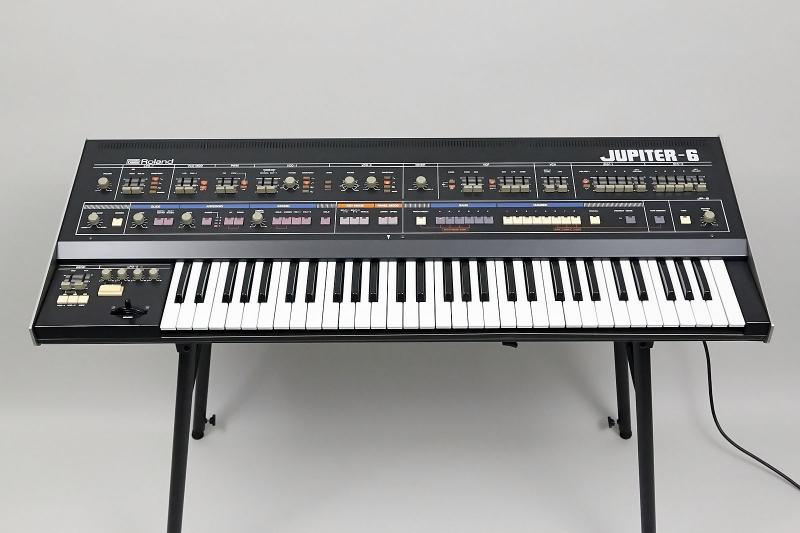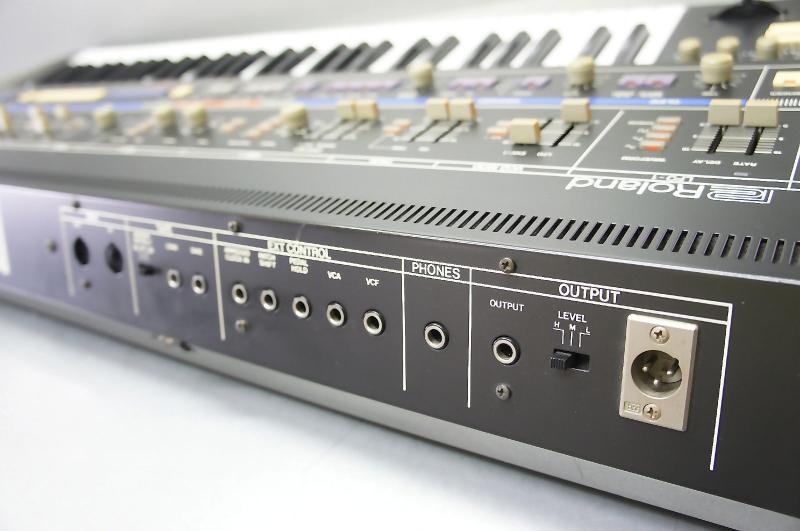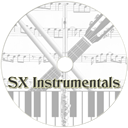Description | The Jupiter 6 is a 6-voice polyphonic synthesizer with a 61-note (C-C) keyboard. Each voice consists of 2 VCOs. VCO1 is switchable between any combination of triangle, sawtooth, pulse, and square waves and can be switched between 4 octaves. VCO2 has the same options, except the square wave is replaced by a noise generator switch and it has a 6 octave range, with an octave above and below VCO1's range.
There is a simple mixer that balances the level of the two oscillators. Two sliders control cross-modulation, the amount that VCO2 modulates VCO1. The first sets the modulation amount and the second sets the amount that this process is controlled by the envelope generator. Pulse Width Modulation (PWM) is set, in much the same way, by two sliders. One slider sets the width, and the other sets the amount the width is modulated by the modulation source. The modulation source (ENV or LFO) and its polarity are set by switches.
The Jupiter 6 also allows Oscillator Sync. VCO1 can be synced to VCO2 or vice-versa. Either or both VCOs can be modulated by either or both of the LFO and ENV1. The LFO features controls for rate, delay, and four waveforms, triangle, saw, square, and random (sample-and-hold). LFO2 is triggered by a big white button next to the pitchbend/modulation lever. There are two knobs, one for pitch (the level of LFO2 routed to the VCO) and the other for filter (the level of LFO2 routed to the VCF). In addition, there are also knobs that control the rise time (how fast LFO2 reaches full amplitude) and the rate of LFO2.
The VCF on the Jupiter 6 is unique amoung the Jupiter series in that it is a multimode filter, with either 4-pole lowpass, 4-pole highpass, or 2-pole bandpass. The filter is resonant in all modes allowing for some interesting resonant sweeps using the highpass and bandpass filter instead of the more common lowpass sweep. However, the Jupiter 6 does not have the separate fixed high-pass filter as do the other Jupiter models. The filter can be modulated by an envelope (either ENV1 or ENV2), the LFO, and keyboard tracking. There is a slider to determine the level of each of the three modulation sources. Both envelopes (ENV1 and ENV2) are ADSR (Attack Decay Sustain Release). A slider controls the amount the envelopes are modulated by key follow. ENV1 can be set to normal or negative polarity. ENV2 is hardwired to control the VCA, with a slider controlling the amount. The bender can affect pitch and/or filter cutoff, each of which has a slider for amount. VCO1 and VCO2 have separate on/off switches for bender modulation. There is also a "wide" bending option, which scales the bender to extreme ranges.
The Jupiter 6's memory can hold 48 patches, and 32 patch presets. Patch presets can store keyboard splits, along with the settings for the arpeggiator, voice assign mode, hold, portamento, as well as many of the modulation settings. The Jupiter 6 features keyboard split, allowing you to assign two voices to the upper split and four voices to the lower or vice-versa. The balance between both sides of the split is controlled by a slider. The arpeggiator is switchable between 1, 2, 3, and 4 octaves and three modes: up, down, or up and down. It can be assigned to work on either the lower or upper split or both. Portamento can be switched between Portamento and Glide. Glide quantizes the portamento into half-steps for a staircase effect. Portamento is separately programmable for both sides of a split.
The Jupiter 6 features Solo, Unison, Solo Unison, Poly 1, and Poly 2 modes. Solo allows you to only play one voice at a time (ie. one 2-oscillator voice). Solo Unison mode limits the voice allocation to one note at a time, but stacks all six voices on that note (as opposed to solo, which uses just a single voice) so that the Jupiter becomes a 12 oscillator, monophonic synthesizer! Unison mode plays all of the voices, all of the time, dividing them as evenly as possible between all sounding notes. That means that if you played a single note, you would hear all 6 voices stacked together. Playing two notes would get three voices apiece, playing three notes would get two, and more than that would get you one or two notes with two voices, and then the rest with a single voice. This offers the flexibility of having a polyphonic keyboard when you need it and the ability to get a fatter sound out of one or two notes. The amount of detuning in Unison mode is programmable for each side of a split. Poly 1 is the normal 6-voice polyphonic mode, and Poly 2 uses normal polyphonic allocation as long as you play legato. Once you lift your hand off the keyboard, any new notes will cut off the releases of all currently sounding notes. This is recommended for use with portamento. "Hold" is equivalent to the sustain pedal, but it is also a programmable parameter - that is, a sound in a Patch Preset can be permanently "held." Hold can be set for either or both sides of a split/layer. Modulation parameters include pitchbend sensitivity, VCO bend range (Wide, Normal, or Off for each of VCO1 and VCO2), aftertouch routing to either filter cutoff or vibrato (from LFO2), and aftertouch sensitivity.
The Jupiter 6 came stock from the factory with a very limited MIDI implementation, notes and program change only (not even the sustain pedal). Early versions powered up in OMNI mode, although they did properly receive OMNI OFF messages. Later versions can power up in POLY mode, and allow you to change the MIDI channel (although this is not memorized after you turn the synth off). That same upgrade allows the instrument to receive on two channels, so that the basic channel plays the upper part of a split, and the next channel (basic channel +1) plays the lower part.
The Jupiter 6 also features external input for control of the VCA and VCF and an input for syncing the arpeggiator to an external clock. There are both 1/4" and balanced XLR outputs. |




